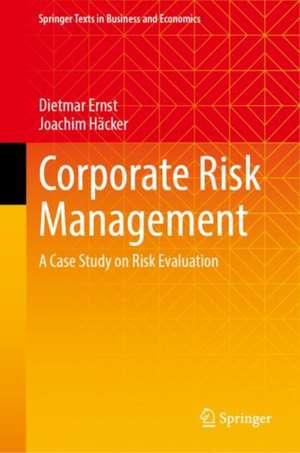Corporate Risk Management : A Case Study on Risk Evaluation: Springer Texts in Business and Economics
Autor Dietmar Ernst, Joachim Häckeren Limba Engleză Hardback – 16 aug 2024
Din seria Springer Texts in Business and Economics
- 17%
 Preț: 395.83 lei
Preț: 395.83 lei -
 Preț: 548.25 lei
Preț: 548.25 lei - 17%
 Preț: 490.71 lei
Preț: 490.71 lei - 13%
 Preț: 447.86 lei
Preț: 447.86 lei - 19%
 Preț: 509.83 lei
Preț: 509.83 lei -
 Preț: 360.02 lei
Preț: 360.02 lei -
 Preț: 338.81 lei
Preț: 338.81 lei - 17%
 Preț: 523.87 lei
Preț: 523.87 lei -
 Preț: 374.15 lei
Preț: 374.15 lei -
 Preț: 185.09 lei
Preț: 185.09 lei - 17%
 Preț: 522.65 lei
Preț: 522.65 lei - 19%
 Preț: 465.61 lei
Preț: 465.61 lei - 15%
 Preț: 642.51 lei
Preț: 642.51 lei - 18%
 Preț: 754.79 lei
Preț: 754.79 lei - 19%
 Preț: 534.44 lei
Preț: 534.44 lei -
 Preț: 360.47 lei
Preț: 360.47 lei -
 Preț: 359.93 lei
Preț: 359.93 lei - 17%
 Preț: 363.29 lei
Preț: 363.29 lei - 17%
 Preț: 363.98 lei
Preț: 363.98 lei -
 Preț: 473.41 lei
Preț: 473.41 lei -
 Preț: 361.12 lei
Preț: 361.12 lei - 8%
 Preț: 428.31 lei
Preț: 428.31 lei - 15%
 Preț: 479.55 lei
Preț: 479.55 lei - 13%
 Preț: 490.93 lei
Preț: 490.93 lei - 15%
 Preț: 650.55 lei
Preț: 650.55 lei -
 Preț: 382.19 lei
Preț: 382.19 lei - 15%
 Preț: 562.13 lei
Preț: 562.13 lei -
 Preț: 367.41 lei
Preț: 367.41 lei -
 Preț: 401.79 lei
Preț: 401.79 lei -
 Preț: 361.89 lei
Preț: 361.89 lei - 15%
 Preț: 562.31 lei
Preț: 562.31 lei - 17%
 Preț: 491.52 lei
Preț: 491.52 lei - 20%
 Preț: 819.24 lei
Preț: 819.24 lei - 15%
 Preț: 597.20 lei
Preț: 597.20 lei -
 Preț: 320.05 lei
Preț: 320.05 lei - 20%
 Preț: 694.03 lei
Preț: 694.03 lei - 20%
 Preț: 693.46 lei
Preț: 693.46 lei -
 Preț: 548.53 lei
Preț: 548.53 lei - 17%
 Preț: 459.67 lei
Preț: 459.67 lei - 17%
 Preț: 366.16 lei
Preț: 366.16 lei - 20%
 Preț: 693.82 lei
Preț: 693.82 lei -
 Preț: 555.90 lei
Preț: 555.90 lei - 9%
 Preț: 766.64 lei
Preț: 766.64 lei
Preț: 533.70 lei
Preț vechi: 580.11 lei
-8% Nou
Puncte Express: 801
Preț estimativ în valută:
102.16€ • 111.00$ • 85.87£
102.16€ • 111.00$ • 85.87£
Carte nepublicată încă
Doresc să fiu notificat când acest titlu va fi disponibil:
Se trimite...
Preluare comenzi: 021 569.72.76
Specificații
ISBN-13: 9783031531255
ISBN-10: 3031531256
Ilustrații: X, 525 p. 119 illus., 110 illus. in color.
Dimensiuni: 155 x 235 mm
Ediția:1st ed. 2024
Editura: Springer Nature Switzerland
Colecția Springer
Seria Springer Texts in Business and Economics
Locul publicării:Cham, Switzerland
ISBN-10: 3031531256
Ilustrații: X, 525 p. 119 illus., 110 illus. in color.
Dimensiuni: 155 x 235 mm
Ediția:1st ed. 2024
Editura: Springer Nature Switzerland
Colecția Springer
Seria Springer Texts in Business and Economics
Locul publicării:Cham, Switzerland
Cuprins
General structure of the case study.- Course 1: Risk Analysis.- Course unit 1: Graphical representation of risks.- Course unit 2: Variance and standard deviation.- Course unit 3: Models for calculating volatility.- Course 2: Quantitative instruments in risk management.- Course unit 1: Different types of Value at Risk and Lower Partial Moments and Extreme Value Theory.- Course unit 2: Determination of portfolio risks.- Course Unit 3: Hedging of hedgeable risks and modelling of non-hedgeable risks.
Notă biografică
Dietmar Ernst is Professor of Corporate Finance at the International School of Finance at the University of Applied Sciences in Nürtingen (Germany). He is also the director of the European Institute of Quantitative Finance (EIQF). Dietmar Ernst worked for many years as an M&A consultant, private equity manager and company valuation specialist in various banks.
Joachim Hacker is Professor of Corporate Finance at the University of Applied Sciences Munich (Germany) and Adjunct Professor at the University of Louisville (USA). He is also Director of the European Institute of Quantitative Finance (EIQF). Prior to his academic career, Joachim Hacker was a Vice President at Rothschild in the Mergers & Acquisitions department in London and Frankfurt. He is also Chairman of the Advisory Board of several companies.
Joachim Hacker is Professor of Corporate Finance at the University of Applied Sciences Munich (Germany) and Adjunct Professor at the University of Louisville (USA). He is also Director of the European Institute of Quantitative Finance (EIQF). Prior to his academic career, Joachim Hacker was a Vice President at Rothschild in the Mergers & Acquisitions department in London and Frankfurt. He is also Chairman of the Advisory Board of several companies.
Textul de pe ultima copertă
In times of crisis, risk management is more important than ever. In addition, companies are obliged to identify, quantify and aggregate risks as part of a risk management system. Legal and auditing standards have set the framework for doing so. This book uses a case study to show ‘step by step’ how risks can be analyzed and quantified with the help of Microsoft Excel. The book begins with the graphical representation of risks and the calculation of risk parameters such as the value at risk. It subsequently aggregates different risks into an overall risk using Monte Carlo simulation. Hedging risks is also explained, and how non-hedgeable risks can be integrated into a business plan. The assessment of extreme risks is also addressed, as is the modeling of volatilities. The book is aimed at students of business administration with a focus on finance.
Caracteristici
Explains step-by-step how to use Excel to analyse risk using Monte Carlo Illustrates how to incorporate hedging risks into a business plan Includes exercises to help students understand the concepts
